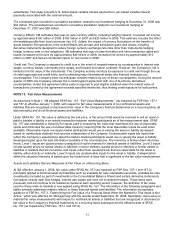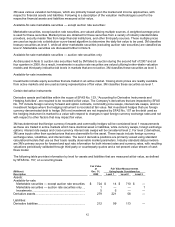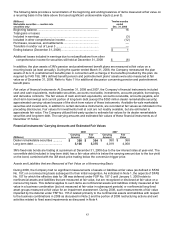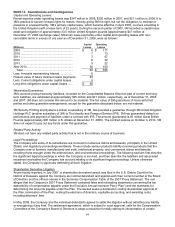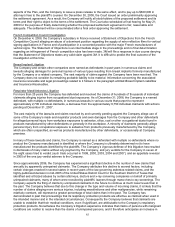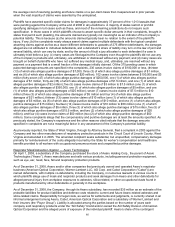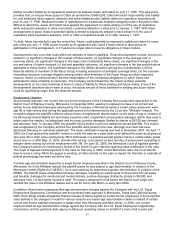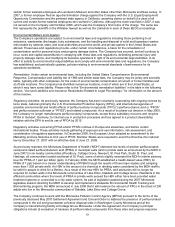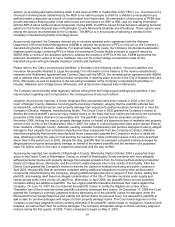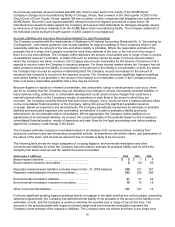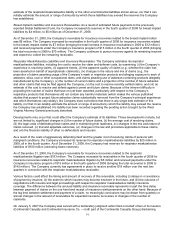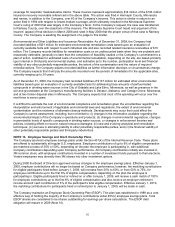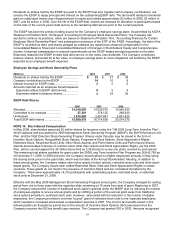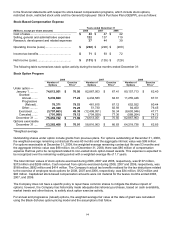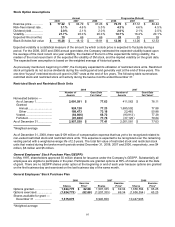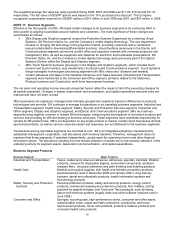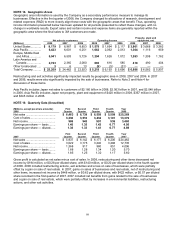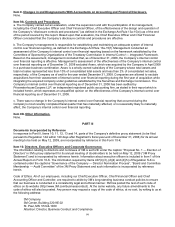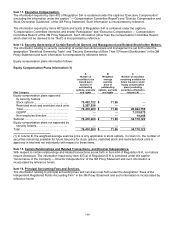3M 2008 Annual Report Download - page 97
Download and view the complete annual report
Please find page 97 of the 2008 3M annual report below. You can navigate through the pages in the report by either clicking on the pages listed below, or by using the keyword search tool below to find specific information within the annual report.91
estimate of the respirator/mask/asbestos liability or the other environmental liabilities shown above, nor that it can
reliably estimate the amount or range of amounts by which those liabilities may exceed the reserves the Company
has established.
Breast Implant Liabilities and Insurance Receivables: As a result of estimated future payments to the previously
reported Global Settlement Fund, the Company increased its reserves in the fourth quarter of 2008 for breast implant
liabilities by $4 million, to $5 million as of December 31, 2008.
As of December 31, 2008, the Company’s receivable for insurance recoveries related to the breast implant matter
was $6 million. The Company increased its receivables in the fourth quarter of 2008 for insurance recoveries related
to the breast implant matter by $7 million (bringing the total increase in insurance receivables in 2008 to $12 million)
and received payments under the Company’s insurance program of $15 million in the fourth quarter of 2008 (bringing
the total recoveries in 2008 to $70 million). The Company continues to pursue recovery against its remaining insurers
and expects to collect the remaining receivable.
Respirator Mask/Asbestos Liabilities and Insurance Receivables: The Company estimates its respirator
mask/asbestos liabilities, including the cost to resolve the claim and defense costs, by examining: (i) the Company’s
experience in resolving claims, (ii) apparent trends, (iii) the apparent quality of claims (e.g., whether the claim has
been asserted on behalf of asymptomatic claimants), (iv) changes in the nature and mix of claims (e.g., the
proportion of claims asserting usage of the Company’s mask or respirator products and alleging exposure to each of
asbestos, silica, coal or other occupational dusts, and claims pleading use of asbestos-containing products allegedly
manufactured by the Company), (v) the number of current claims and a projection of the number of future asbestos
and other claims that may be filed against the Company, (vi) the cost to resolve recently settled claims, and (vii) an
estimate of the cost to resolve and defend against current and future claims. Because of the inherent difficulty in
projecting the number of claims that have not yet been asserted, particularly with respect to the Company’s
respiratory products that themselves did not contain any harmful materials (which makes the various published
studies that purport to project future asbestos claims substantially removed from the Company’s principal experience
and which themselves vary widely), the Company does not believe that there is any single best estimate of this
liability, nor that it can reliably estimate the amount or range of amounts by which the liability may exceed the reserve
the Company has established. No liability has been recorded regarding the pending action brought by the West
Virginia Attorney General previously described.
Developments may occur that could affect the Company’s estimate of its liabilities. These developments include, but
are not limited to, significant changes in (i) the number of future claims, (ii) the average cost of resolving claims,
(iii) the legal costs of defending these claims and in maintaining trial readiness, (iv) changes in the mix and nature of
claims received, (v) trial and appellate outcomes, (vi) changes in the law and procedure applicable to these claims,
and (vii) the financial viability of other co-defendants and insurers.
As a result of the costs of aggressively defending itself and the greater cost of resolving claims of persons with
malignant conditions, the Company increased its reserves for respirator mask/asbestos liabilities by $25 million in
2008, all in the fourth quarter. As of December 31, 2008, the Company had reserves for respirator mask/asbestos
liabilities of $105 million (excluding Aearo reserves).
As of December 31, 2008, the Company’s receivable for insurance recoveries related to the respirator
mask/asbestos litigation was $193 million. The Company increased its receivables in the fourth quarter of 2008 for
insurance recoveries related to respirator mask/asbestos litigation by $6 million and received payments under the
Company’s insurance program of $13 million in the fourth quarter of 2008 (bringing the total recoveries in 2008 to
$145 million). The Company currently has agreements in place to receive another $18 million over the next two
quarters in connection with the respirator mask/asbestos receivable.
Various factors could affect the timing and amount of recovery of this receivable, including (i) delays in or avoidance
of payment by insurers; (ii) the extent to which insurers may become insolvent in the future, and (iii) the outcome of
negotiations with insurers and legal proceedings with respect to respirator mask/asbestos liability insurance
coverage. The difference between the accrued liability and insurance receivable represents in part the time delay
between payment of claims on the one hand and receipt of insurance reimbursements on the other hand. Because of
the lag time between settlement and payment of a claim, no meaningful conclusions may be drawn from quarterly or
annual changes in the amount of receivables for expected insurance recoveries or changes in the number of
claimants.
On January 5, 2007 the Company was served with a declaratory judgment action filed on behalf of two of its insurers
(Continental Casualty and Continental Insurance Co. — both part of the Continental Casualty Group) disclaiming


